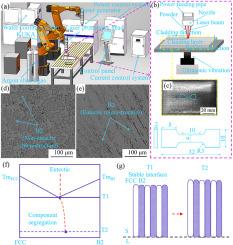The effect of ultrasound on the synergistic improvement of strength and plasticity of laser-cladded AlCoCrFeNi2.1 coatings
IF 4.8
2区 材料科学
Q2 CHEMISTRY, PHYSICAL
引用次数: 0
Abstract
Ultrasound may enhance the concurrent formation of the B2 (AlNi) phase in conjunction with the FCC (CrFeCo) matrix phase during the laser cladding process. This enhancement leads to a reduction in the interphase distance and promotes a strong bonding interaction between the two phases. In comparison to the coatings prepared without ultrasonic assistance, the ultrasonic-assisted coatings exhibit a reduction in the average wear coefficient from 0.4439 to 0.4022, and a decrease in the mass wear rate from 8.8 × 10−4 g/m to 6.4 × 10−4 g/m. When compared to coatings fabricated without the aid of ultrasonic assistance, those produced with ultrasonic exhibit enhanced tensile strength and elongation, with values rising from 1487 MPa to 10.77 % to 2037 MPa and 17.28 %, respectively. Additionally, there is a notable change in the fracture morphology, shifting from clearly defined tearing edges to a more homogeneous ductile dimple structure. Coatings produced with the aid of ultrasound demonstrate an enhanced capacity to transfer tensile loads from the FCC phase to the high-strength B2 phase during the tensile process. This mechanism promotes the full exploitation of the synergistic effects of strength and toughness that exist between the two phases.

超声对激光熔覆AlCoCrFeNi2.1涂层强度和塑性协同提高的影响
在激光熔覆过程中,超声可以增强B2 (AlNi)相与FCC (CrFeCo)基体相的同时形成。这种增强导致相间距离的减小,并促进了两相之间的强键相互作用。与无超声辅助涂层相比,超声辅助涂层的平均磨损系数从0.4439降低到0.4022,质量磨损率从8.8 × 10−4 g/m降低到6.4 × 10−4 g/m。与无超声辅助制备的涂层相比,超声辅助制备的涂层的抗拉强度和伸长率分别从1487 MPa提高到10.77%、2037 MPa和17.28%。此外,断口形态也发生了显著变化,从清晰的撕裂边缘转变为更均匀的韧性韧窝结构。超声辅助下生产的涂层在拉伸过程中将拉伸载荷从FCC相转移到高强度B2相的能力增强。这种机制促进了两相之间存在的强度和韧性的协同效应的充分利用。
本文章由计算机程序翻译,如有差异,请以英文原文为准。
求助全文
约1分钟内获得全文
求助全文
来源期刊

Intermetallics
工程技术-材料科学:综合
CiteScore
7.80
自引率
9.10%
发文量
291
审稿时长
37 days
期刊介绍:
This journal is a platform for publishing innovative research and overviews for advancing our understanding of the structure, property, and functionality of complex metallic alloys, including intermetallics, metallic glasses, and high entropy alloys.
The journal reports the science and engineering of metallic materials in the following aspects:
Theories and experiments which address the relationship between property and structure in all length scales.
Physical modeling and numerical simulations which provide a comprehensive understanding of experimental observations.
Stimulated methodologies to characterize the structure and chemistry of materials that correlate the properties.
Technological applications resulting from the understanding of property-structure relationship in materials.
Novel and cutting-edge results warranting rapid communication.
The journal also publishes special issues on selected topics and overviews by invitation only.
 求助内容:
求助内容: 应助结果提醒方式:
应助结果提醒方式:


